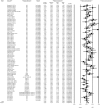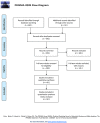The Association between High Fat Diet around Gestation and Metabolic Syndrome-related Phenotypes in Rats: A Systematic Review and Meta-Analysis
- PMID: 28698653
- PMCID: PMC5506021
- DOI: 10.1038/s41598-017-05344-7
The Association between High Fat Diet around Gestation and Metabolic Syndrome-related Phenotypes in Rats: A Systematic Review and Meta-Analysis
Abstract
Numerous rodent studies have evaluated the effects of a maternal high-fat diet (HFD) on later in life susceptibility to Metabolic Syndrome (MetS) with varying results. Our aim was to quantitatively synthesize the available data on effects of maternal HFD around gestation on offspring's body mass, body fat, plasma leptin, glucose, insulin, lipids and systolic blood pressure (SBP). Literature was screened and summary estimates of the effect of maternal HFD on outcomes were calculated by using fixed- or random-effects models. 362 effect sizes from 68 studies together with relevant moderators were collected. We found that maternal HFD is statistically associated with higher body fat, body weight, leptin, glucose, insulin and triglycerides levels, together with increased SBP in offspring later in life. Our analysis also revealed non-significant overall effect on offspring's HDL-cholesterol. A main source of variation among studies emerged from rat strain and lard-based diet type. Strain and sex -specific effects on particular data subsets were detected. Recommendations are suggested for future research in the field of developmental programming of the MetS. Despite significant heterogeneity, our meta-analysis confirms that maternal HFD had long-term metabolic effects in offspring.
Conflict of interest statement
The authors declare that they have no competing interests.
Figures










Similar articles
-
Systematic review and meta-analysis on the relationship between prenatal stress and metabolic syndrome intermediate phenotypes.Int J Obes (Lond). 2020 Jan;44(1):1-12. doi: 10.1038/s41366-019-0423-z. Epub 2019 Jul 22. Int J Obes (Lond). 2020. PMID: 31332277
-
Prenatal stress and later metabolic consequences: Systematic review and meta-analysis in rodents.Psychoneuroendocrinology. 2020 Mar;113:104560. doi: 10.1016/j.psyneuen.2019.104560. Epub 2019 Dec 20. Psychoneuroendocrinology. 2020. PMID: 31884321
-
Adverse Effect of High-Fat Diet on Metabolic Programming in Offspring Born to a Murine Model of Maternal Hypertension.Am J Hypertens. 2016 Dec 1;29(12):1366-1373. doi: 10.1093/ajh/hpw088. Am J Hypertens. 2016. PMID: 27565786
-
A low maternal protein diet during pregnancy and lactation has sex- and window of exposure-specific effects on offspring growth and food intake, glucose metabolism and serum leptin in the rat.J Physiol. 2006 Feb 15;571(Pt 1):221-30. doi: 10.1113/jphysiol.2005.100313. Epub 2005 Dec 8. J Physiol. 2006. PMID: 16339179 Free PMC article.
-
Voluntary post weaning exercise restores metabolic homeostasis in offspring of obese rats.Nutr Metab Cardiovasc Dis. 2013 Jun;23(6):574-81. doi: 10.1016/j.numecd.2011.12.009. Epub 2012 Feb 3. Nutr Metab Cardiovasc Dis. 2013. PMID: 22305126
Cited by
-
Systematic review and meta-analysis on the relationship between prenatal stress and metabolic syndrome intermediate phenotypes.Int J Obes (Lond). 2020 Jan;44(1):1-12. doi: 10.1038/s41366-019-0423-z. Epub 2019 Jul 22. Int J Obes (Lond). 2020. PMID: 31332277
-
Maternal Diabetes and Postnatal High-Fat Diet on Pregnant Offspring.Front Cell Dev Biol. 2022 May 30;10:818621. doi: 10.3389/fcell.2022.818621. eCollection 2022. Front Cell Dev Biol. 2022. PMID: 35706903 Free PMC article.
-
Modeling the Western Diet for Preclinical Investigations.Adv Nutr. 2018 May 1;9(3):263-271. doi: 10.1093/advances/nmy002. Adv Nutr. 2018. PMID: 29635305 Free PMC article. Review.
-
Oxidative Stress Profile of Mothers and Their Offspring after Maternal Consumption of High-Fat Diet in Rodents: A Systematic Review and Meta-Analysis.Oxid Med Cell Longev. 2021 Nov 24;2021:9073859. doi: 10.1155/2021/9073859. eCollection 2021. Oxid Med Cell Longev. 2021. PMID: 34868458 Free PMC article.
-
Early Roots of Childhood Obesity: Risk Factors, Mechanisms, and Prevention Strategies.Int J Mol Sci. 2025 Jul 30;26(15):7388. doi: 10.3390/ijms26157388. Int J Mol Sci. 2025. PMID: 40806516 Free PMC article. Review.
References
-
- Alberti KG, et al. Harmonizing the metabolic syndrome: a joint interim statement of the International Diabetes Federation Task Force on Epidemiology and Prevention; National Heart, Lung, and Blood Institute; American Heart Association; World Heart Federation; International Atherosclerosis Society; and International Association for the Study of Obesity. Circulation. 2009;120:1640–1645. doi: 10.1161/CIRCULATIONAHA.109.192644. - DOI - PubMed
Publication types
MeSH terms
Substances
LinkOut - more resources
Full Text Sources
Other Literature Sources
Medical

